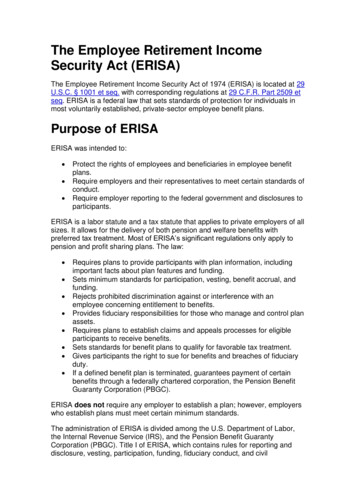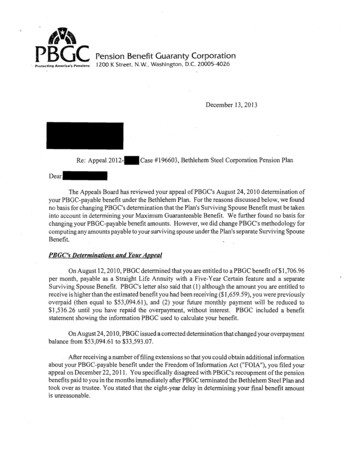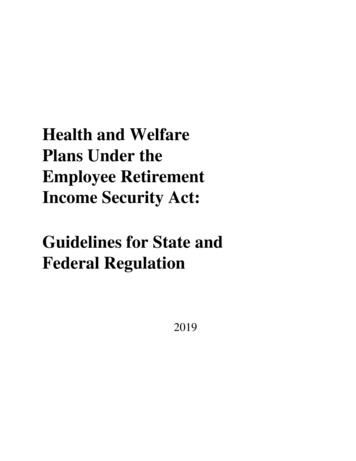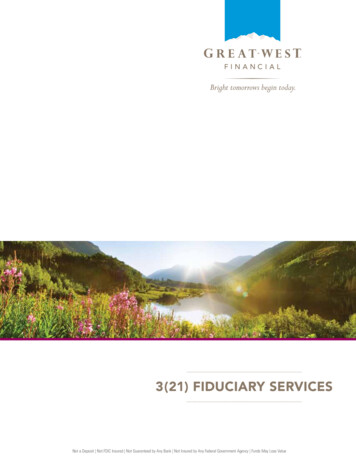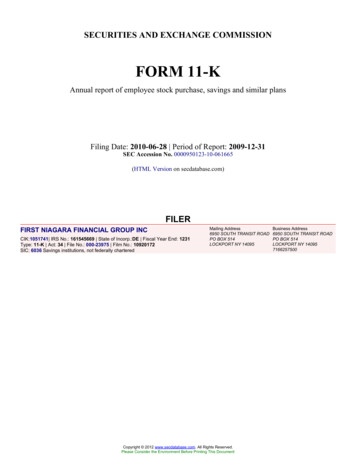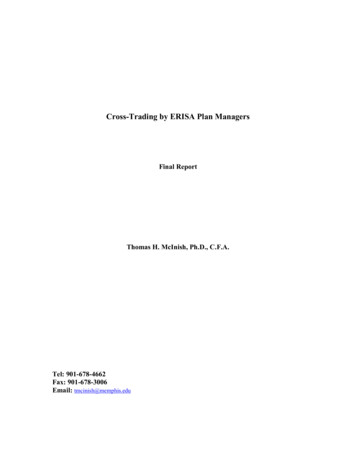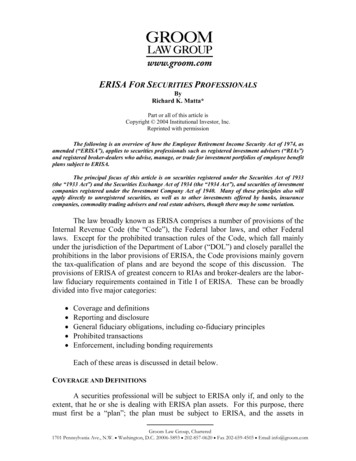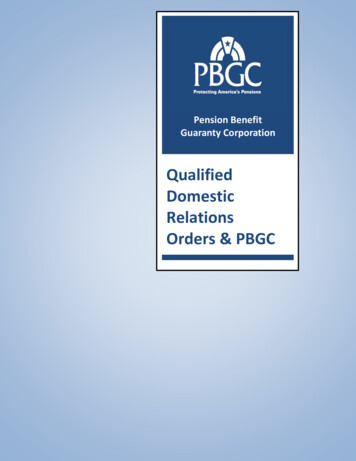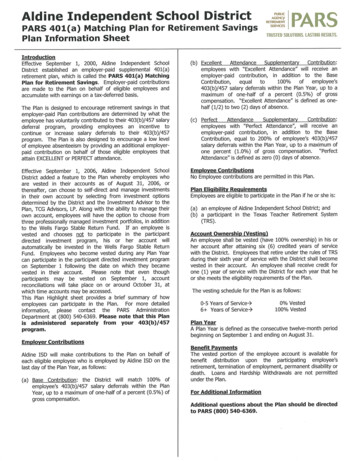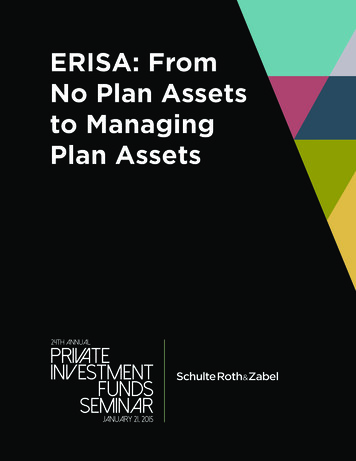
Transcription
ERISA: FromNo Plan Assetsto ManagingPlan Assets
David M. CohenPartnerNew York Office 1 212.756.2141david.cohen@srz.comPracticesEmployment &Employee BenefitsHedge FundsPrivate EquityRegulatory & ComplianceTrading AgreementsDavid focuses his practice on matters related to fiduciary responsibility,the Employee Retirement Income Security Act of 1974 (ERISA) andqualified plans. Prior to joining SRZ, David held positions in both theprivate sector (as vice president and assistant general counsel of a majorinvestment firm) and government service (with the Department of LaborEmployee Benefits Security Administration’s Divisions of RegulatoryCoordination and Exemptions).In recognition of his accomplishments, David has been selected forinclusion in Chambers USA, The Best Lawyers in America and in New YorkSuper Lawyers, a listing of outstanding attorneys in the New York metroarea. He has spoken and written widely on ERISA and benefit fundrelated issues, including authoring ERISA compliance guides for brokerdealers for Practising Law Institute. He is also a co-author of HedgeFunds: Formation, Operation and Regulation (ALM Law Journal Press).David recently presented “What You Need to Know When ERISA PlansCome Knocking” at the SRZ London Breakfast Briefing and “CurrentFiduciary Issues” at the Practising Law Institute Pension Plan Investments2014: Current Perspectives conference.David earned a J.D. from The George Washington University Law Schooland a B.A. from Columbia University.24th Annual Private Investment Funds Seminar 2015 Schulte Roth & Zabel LLP
Jennifer DunnPartnerNew York Office 1 nt ManagementHedge FundsPrivate EquityJennifer advises hedge funds, private equity funds (including mezzanineand distressed funds), hybrid funds, funds of funds and investmentadvisers in connection with their structuring, formation and ongoingoperational needs, general securities law matters, and regulatory andcompliance issues. Her experience includes structuring and negotiatingseed and strategic investments, advising investment managers regardingthe structure and sale of their investment management businesses andthe structure of their compensation arrangements, and representinginvestment managers in connection with managed accounts and singleinvestor funds.Recognized by The Legal 500 United States and the Expert Guide tothe World’s Leading Women in Business Law (Investment Funds) andas an IFLR 1000 Rising Star (Investment Funds), Jennifer recently coauthored Hedge Funds: Formation, Operation and Regulation (ALM LawJournal Press) and presented at conferences sponsored by the NewYork City Bar Association, 100 Women in Hedge Funds, KPMG and Bankof America Merrill Lynch. She also presented “Marketing Opportunitiesand Challenges” at the SRZ 23rd Annual Private Investment FundsSeminar and participated in the “Allocation of Investment OpportunitiesWorkshop” at an SRZ Investment Management Hot Topics seminar.Jennifer earned her J.D. from Columbia University Law School, whereshe was a Harlan Fiske Stone Scholar, and her B.A., cum laude, from theUniversity of Pennsylvania.24th Annual Private Investment Funds Seminar 2015 Schulte Roth & Zabel LLP
Steven J. FredmanPartnerNew York Office 1 ent ManagementHedge FundsPrivate EquityRegulatory & ComplianceSecurities & Capital MarketsSteve is co-head of SRZ’s Investment Management Group. Heconcentrates his practice in the areas of investment funds (domesticand offshore), investment advisers and broker-dealers, the acquisitionand related financing of investment management firms, and securitiesregulation. Steve structures and organizes private investmentpartnerships and offshore funds, including general equity, arbitrage,global investment, private equity, distressed company, small cap andfunds of funds, and he counsels clients on issues relating to partnershiplaw, new product development and other matters. He also structuresand organizes investment advisers and broker-dealers, handles theregistration of commodity pool operators and commodity tradingadvisers, and provides ongoing advice to investment advisers onsecurities laws, rules, regulations and information. He represents clients inconnection with the acquisition and sale of investment management firmsor their assets as well.Steve is recognized by many ranking publications, including ChambersGlobal, Chambers USA, The Legal 500 United States, Expert Guide: Bestof the Best USA (Investment Funds), Expert Guide to the World’s LeadingInvestment Funds Lawyers, Expert Guide to the World’s Leading PrivateEquity Lawyers, International Who’s Who of Private Funds Lawyersand The Best Lawyers in America. A past member of the AmericanBar Association’s Committee on Partnership and the New York CityBar Association’s Committee on Art Law, Steve is a frequent speakerand writer in his areas of expertise. He most recently presented at theGoldman Sachs Seventeenth Annual Hedge Fund Conference, and hediscussed “Distressed Investments: Structured Products” at the SRZ 23rdAnnual Private Investment Funds Seminar. He is a co-author of HedgeFunds: Formation, Operation and Regulation (ALM Law Journal Press)and “Asset Manager M&A Deals,” an SRZ white paper.Steve holds a J.D. from Georgetown University Law Center, where hewas an editor of Law and Policy in International Business, and a B.A. fromColumbia University, where he was Phi Beta Kappa.24th Annual Private Investment Funds Seminar 2015 Schulte Roth & Zabel LLP
Ian L. LevinPartnerNew York Office 1 212.756.2529ian.levin@srz.comPracticesEmployment &Employee BenefitsMergers & AcquisitionsExecutive CompensationIan’s practice concentrates on executive compensation and employeebenefits, with a focus on the employee benefit aspects of mergers andacquisitions and issues arising from the investment of pension planassets. He represents both executives and companies with respect tothe negotiation and drafting of executive employment agreementsand advises as to the design and establishment of virtually all types ofemployee benefit arrangements ranging from cash incentive, equity,deferred compensation and change-in-control arrangements to broadbased retirement and welfare plans. He also advises clients on fiduciaryand plan asset requirements of ERISA, including the structure andoffering of various securities and securities products; the formationand ongoing compliance of private equity and hedge funds; theadministration, management and investment of employee benefitplans; and compliance with ERISA’s various prohibited transaction rulesand exemptions.Ian has been recognized as a leading employment and employee benefitsattorney by The Legal 500 United States, which noted that he “operatesat a very high level across many areas, but brings a particularly uniqueset of skills to ERISA Title I matters in his representation of privateinvestment funds.” He also serves as an adjunct professor at New YorkLaw School. Ian has written articles for The Metropolitan CorporateCounsel about ERISA and incentive-based compensation regulations,and his recent speaking engagements include addressing several NewYork City Bar Association conferences.Ian received his LL.M. from New York University School of Law, his J.D.from Emory University School of Law and his B.A. from Union College.24th Annual Private Investment Funds Seminar 2015 Schulte Roth & Zabel LLP
Ronald E. RichmanPartnerNew York Office 1 ent &Employee BenefitsMergers & AcquisitionsRegulatory & ComplianceInsuranceExecutive CompensationRon is co-head of SRZ’s Employment & Employee Benefits Group anda member of the firm’s Executive Committee. His practice concentrateson the litigation of employment and employee benefits cases in federaland state courts throughout the United States involving trade secrets,non-competition, non-solicit, and breach of confidentiality and breachof loyalty issues. Ron defends employee benefit plans, fiduciaries, andemployers in class actions and in cases brought by individual plaintiffs.He represents employee benefit plans before the U.S. Departmentof Labor, the Pension Benefit Guaranty Corporation and the InternalRevenue Service in connection with novel issues of law concerningplan mergers, terminations, spin-offs, fiduciary duties and prohibitedtransactions, and various aspects of withdrawal liability and masswithdrawal liability. He also represents employers (particularly hedgeand private equity funds), employees and partners with respect toexecutive compensation and partnership issues.Recognized by New York Super Lawyers and The Best Lawyers in Americaas a leading labor and employment litigation attorney, Ron is a Fellow ofthe American College of Employee Benefits Counsel and a member ofthe CPR Employment Dispute Committee of the CPR Institute for DisputeResolution. He is a former board member for the Lawyers Alliance forNew York and a former adjunct professor in the New York UniversitySchool of Continuing Education’s Certified Employee Benefits SpecialistProgram. Ron frequently speaks and writes on employee benefits andemployment topics of interest to the human resources community. Hemost recently presented “Understanding Pension Plan Liabilities” at theSRZ 3rd Annual Distressed Investing Conference, and he participatedin an SRZ Employment & Employee Benefits Luncheon for InvestmentManagers. He also recently published “ERISA Presumption of Prudence in‘Stock Drop’ Cases Rejected” in the New York Law Journal.Ron received his J.D. from Columbia University School of Law, wherehe was a Harlan Fiske Stone Scholar and the recipient of the EmilSchlesinger Labor Law Prize, and his B.S. from the Industrial and LaborRelations School at Cornell University.24th Annual Private Investment Funds Seminar 2015 Schulte Roth & Zabel LLP
ERISA: From No Plan Assets to Managing Plan AssetsIntroductionThe Employee Retirement Income Security Act of 1974 (“ERISA”) imposes significant responsibilities (so-called“fiduciary responsibilities”) on persons who manage or provide services to employee benefit plans, directly orthrough so-called plan asset look-through vehicles, and it imposes important restrictions on transactionsinvolving employee benefit plans (or involving the investment of the assets of such plans). Additionalresponsibilities and restrictions are imposed under the Internal Revenue Code of 1986 (the “Code”). This outlinesummarizes the most important of these rules and restrictions applicable to managers of hedge funds incircumstances in which investment in the fund by employee benefit plans causes the hedge fund to be a “planasset look-through vehicle.”ERISA operates by: (1) prohibiting broad categories of transactions between a plan and the people who manageor provide services to the plans; (2) providing statutory exemptions from all or part of the prohibitions forspecific kinds of transactions; and (3) permitting the Department of Labor (“DOL”) to grant individual orindustry-wide exemptions (“class exemptions”) from all or part of the prohibitions for specific kinds oftransactions. Therefore, analyzing whether a particular transaction is permissible is usually a two-step process:First, does the transaction or service fall within the broad prohibitions? If so, then second, is any exemptionavailable to permit the transaction or service? To the extent that an exemption is available, the hedge fundmanager must understand and strictly comply with the conditions set forth in the exemption. Failure to do somay render the exemption meaningless.This outline is organized as follows:Section I contains a discussion of the terms used in ERISA and summarizes the broad prohibitions of ERISA.Section II discusses the circumstances in which the investment by employee benefit plans in a hedge fundwill cause the fund to be a plan asset look-through vehicle that is subject to ERISA, and the consequencesto the fund’s investment manager if the fund attains plan asset look-through status.Section III discusses the consequences to an ERISA-covered plan of investing in a plan asset look-throughhedge fund.Section IV discusses a specific class exemption (the so-called “QPAM Exemption”) issued by the DOL thatpermits certain categories of transactions and services in the event that a hedge fund attains plan assetlook-through status.Section V discusses a specific statutory exemption that permits certain categories of transactions andservices in the event that a hedge fund attains plan asset look-through status.Section VI discusses special prohibited transaction concerns that arise in managing a plan asset lookthrough hedge fund and how to handle those concerns.Section VII discusses increasing ERISA capacity while trying to avoid plan asset look-through status, alsoknown as “the hard wired feeder concept.”I.General Application of the Fiduciary ProvisionsA. Coverage24th Annual Private Investment Funds Seminar 1 2015 Schulte Roth & Zabel LLP
1.ERISAThe fiduciary responsibility and prohibited transaction provisions of Title I of ERISA, which imposeresponsibilities on plan fiduciaries and which regulate plan dealings with providers of services andother parties in interest, apply generally to “employee benefit plans,” whether or not such plans are1“qualified plans” under the Code. However, a DOL regulation provides that the term “employeebenefit plan” does not include: (1) an individual retirement account, annuity or bond created by an2individual employee, to which his employer does not contribute; (2) a plan which covers only the3sole owner of a business (incorporated or unincorporated) and/or his spouse (a “one-man” plan);4or (3) a plan which covers only partners and their spouses (a “partner-only” plan).NOTE: Although IRAs, one-man plans and partner-only plans are not covered by ERISA’s fiduciaryresponsibility rules, they are subject to restrictions imposed by the Code, as discussed below.ERISA also excludes from its fiduciary responsibility rules those plans maintained by governmentalbodies, certain plans maintained by churches and certain plans maintained by private employersprimarily for the purposes of providing deferred compensation for a select group of management orhighly compensated employees. However, plans maintained by tax-exempt organizations other than5governmental bodies and churches are subject to ERISA’s fiduciary responsibility provisions, andgovernmental plans may be subject to ERISA-like fiduciary responsibility rules imposed under statelaw.2.Internal Revenue CodeThe provisions of the Code regulating transactions involving employee benefit plans apply toindividual retirement accounts, annuities or bonds, and so-called “qualified plans” (including oneman plans and partner-only plans). Although the prohibited transaction provisions of the Codegenerally do not apply to non-qualified employee benefit plans, they do continue to apply to a plan6that was once qualified but later became disqualified.NOTE: It is important to keep in mind that, since IRAs, one-man plans and partner-only plans aresubject to the Code, the prohibited transaction rules imposed by the Code apply to these accountsand plans even though they are exempt from the ERISA fiduciary responsibility rules. The fiduciaryobligations imposed solely by ERISA, which do not apply, are summarized in part D of Section I. Theprohibited transaction rules, which are imposed both by ERISA and by the Code, and which doapply to IRAs, one-man plans and partner-only plans, are summarized in part E of Section I.B.Definition of FiduciaryERISA and the Code regulate the activities of “fiduciaries.” A person is a fiduciary with respect to a planasset look-through hedge fund to the extent he or it:123456ERISA § 401(a); 3(3).Labor Reg. § 2510.3-2(d).Labor Reg. § 2510.3-3(b).Labor Reg. § 2510.3-3(b).DOL News Release (Jan. 12, 1987).Code § 4975(e)(1).24th Annual Private Investment Funds Seminar 2 2015 Schulte Roth & Zabel LLP
1.Exercises any discretionary authority or control with respect to the management of a fund or themanagement or disposition of the fund’s assets;2.Renders investment advice to the fund for a fee or compensation, direct or indirect, with respect toany moneys or property of the fund or has any authority or responsibility to do so; or3.Has any discretionary authority or discretionary responsibility in administering the fund.7This statutory test is a purely functional test. Thus, the fiduciary of a plan asset look-through hedge fundwill be the entity that calls the investment shots for the fund. Depending on the structure of the fund,this may not be the general partner of a partnership, the managing member of an LLC or the board ofdirectors of an offshore corporation if such person or entity does not perform any of the functions setforth in the statute and quoted above.C.Definition of Party in InterestERISA and the Code also restrict transactions involving a plan and a “party in interest.” The Code doesnot use the term “party in interest” but refers instead to a “disqualified person.” The definition of a“disqualified person,” though not identical to that of “party in interest,” is sufficiently similar so that, forsimplicity, the term “party in interest” will be deemed to include a “disqualified person” for purposes ofthis outline. A “party in interest” is defined to include:1.Any fiduciary (including by definition a trustee);2.Any person providing services to a plan;3.An employer whose employees are covered by the plan;4.A union or other employee organization whose members are covered by the plan;5.An owner of a 50-percent or more interest in an entity described in (3) or (4);6.A relative of an individual described in (1), (2), (3) or (5). “Relative” includes a spouse, ancestor,8lineal descendant or spouse of a lineal descendant;7.An entity 50 percent or more of which is controlled, directly or indirectly, by individuals or entitiesdescribed in (1), (2), (3), (4) or (5);8.An employee, officer, director or a person directly or indirectly controlling 10 percent or more of anindividual or entity described in (2), (3), (4), (5) or (7); or9.A person who is a 10 percent or more partner or joint venturer in an individual or entity described in9(2), (3), (4), (5) or (7).(The percentages in (7), (8) and (9) may be, but have not been, lowered by regulation.)D. General Duties of a Fiduciary789ERISA § 3(21)(A); Code § 4975(e)(3).ERISA § 3(15); Code § 4975(e)(6).ERISA § 3(14); Code § 4975(e)(2); Advisory Opinion 75-147.24th Annual Private Investment Funds Seminar 3 2015 Schulte Roth & Zabel LLP
Under ERISA, a fiduciary’s general obligations with respect to a plan asset look-through hedge fund are,briefly, the following:1.He must discharge his duties solely in the interest of participants and beneficiaries of the investingERISA-covered employee benefit plans for the exclusive purpose of providing benefits under and10defraying reasonable administrative costs of such plans.2.He must act with the care, skill, prudence and diligence under the prevailing circumstances that aprudent man acting in a like capacity and familiar with such matters would use in the conduct of an11enterprise of a like character and like aims.3.He must diversify plan investments so as to minimize the risk of large losses (with certain very12limited exceptions).4.He must discharge his duties in accordance with the documents governing the investing plans to13the extent that such documents are consistent with ERISA.5.Except as authorized by regulation, he may not maintain title to assets of the fund outside the14jurisdiction of the district courts of the United States. The DOL issued a regulation that allows15certain persons to maintain assets outside the United States under limited circumstances. Underthis regulation, a fiduciary may purchase securities issued by a foreign corporation or governmentalentity, or whose principal trading market is outside of the United States, if the fiduciary is acorporation or partnership organized under United States or state law that has its principal place ofbusiness in the United States, provided that the fiduciary is a registered investment adviser (or abank or insurance company) with 50,000,000 under management and either: (1) over 750,000 inshareholders’ or partners’ equity; or (2) all of its liabilities are assumed or guaranteed by a bank,insurance company, another investment adviser with over 750,000 in shareholders’ or partners’equity, or a registered broker or dealer with a net worth of over 750,000.6.He may not permit the fund to acquire or hold employer securities or employer real property of the16investing plans in excess of certain specified limitations.Under applicable DOL regulations, a fiduciary is considered to satisfy the requirement that he act withthe care, skill, prudence and diligence of a prudent man with respect to his investment duties if, withregard to a particular investment or investment course of action, he gives appropriate consideration ofthe facts and circumstances which, given the scope of his investment duties, he knows or should knoware relevant to a particular investment or investment course of action. Thus, under the regulation, thefiduciary should consider the role that the particular investment or investment course of action plays inthe fund’s overall investment portfolio. The fiduciary should determine whether the particularinvestment or investment course of action is reasonably designed, as part of the fund’s investmentportfolio, to further the purpose of the fund given the risk of loss and opportunity for gain (or other10ERISA § 404(a)(1)(A); Code § 401(a).11ERISA § 404(a)(1)(B). This is sometimes referred to as the prudent expert standard. It is a higher standard than the common law fiduciarystandard of a general partner to a partnership.1213141516ERISA § 404(a)(1)(C).ERISA § 404(a)(1)(D).ERISA § 404(b).Labor Reg. § 2550.404b-l.ERISA § 406(a)(2).24th Annual Private Investment Funds Seminar 4 2015 Schulte Roth & Zabel LLP
return) associated with the investment. Among the factors that a fiduciary should consider are thecomposition of the fund’s investment portfolio and its diversity or lack thereof, the liquidity, rate ofreturn and cash flow needs of the fund and the projected return from the fund’s investments relative toother types of investments.E.Prohibited TransactionsUnder ERISA, a fiduciary may not engage in a prohibited transaction with a plan asset look-throughhedge fund nor cause the fund to engage in a prohibited transaction with a party in interest. Thepenalties imposed on fiduciaries and on parties in interest for violations of these rules are discussed indetail in Appendix A. Except as otherwise indicated below, these rules are imposed both by ERISA andby the Code.1.Prohibited transactions involving fiduciary self-dealing:(a) Dealing with the assets of the plan in the fiduciary’s own interest or for his own account (e.g.,effecting a securities transaction through a broker-dealer that is an affiliate of the plan assetlook-through hedge fund manager or purchasing a security with fund assets for the purpose ofmaintaining the price of the security for the benefit of such a broker-dealer or its other17customers).(b) Acting on behalf of a party whose interests are adverse to the interests of the plan in anytransactions involving the plan (e.g., the manager of a plan asset look-through hedge fund18crosses the fund’s securities trades with another hedge fund managed by the same manager).(ERISA only.)(c) Receiving any consideration for its own account from any party dealing with the plan inconnection with a transaction involving the plan’s assets (e.g., the manager of a plan asset lookthrough hedge fund receives a fee or other thing of value from an unaffiliated broker in return19for the manager selecting that broker to execute trades for the fund).These prohibited transaction rules are intended to prevent the fiduciary from engaging in any actsof self-dealing or in transactions where the fiduciary has, or may have, a conflict of interest.2.Prohibited transactions between a party in interest (including any fiduciary) and a plan asset lookthrough hedge fund:(a) Sale, exchange or lease of property.20(b) Loans and other extensions of credit, including margin loans and short sales. (However, see theexemption for certain margin loans and short sales discussed below in Section IV of this21outline.)(c) Furnishing of goods, services or facilities.17ERISA § 406(b)(1); Code § 4975(c)(1)(E).18ERISA § 406(b)(2).19ERISA § 406(b)(3); Code § 4975(c)(1)(F). A violation of this section may give rise to criminal penalties. 18 U.S.C. § 1954.202122ERISA § 406(a)(1)(A); Code § 4975(c)(1)(A).ERISA § 406(a)(1)(B); Code § 4975(c)(1)(B).24th Annual Private Investment Funds Seminar 5 2015 Schulte Roth & Zabel LLP
(d) Transfers to, or use by a party in interest of, any fund assets.23(e) Subject to certain exceptions, acquisition by a party in interest, on behalf of the fund, of any24employer security or employer real property. (ERISA only.)F.Liability for Breach of Co-FiduciaryIn addition to any liability that a fiduciary may have for his own breaches of fiduciary duty, he is liablefor the breach of another fiduciary of the same plan asset look-through hedge fund if:1.He knowingly participates in or undertakes to conceal a breach of fiduciary duty which he knows tobe a breach;2.He enabled such fiduciary to commit the breach by not discharging his own fiduciary dutiesproperly; or3.He is aware that the breach has occurred, unless he takes reasonable steps to remedy the breach.25Accordingly, if one plan fiduciary has knowledge of another plan fiduciary’s breach of fiduciaryresponsibility, he has an affirmative duty to make reasonable efforts to remedy the breach. Failure to doso will expose the fiduciary to potential liability for the acts of the offending fiduciary. The DOLregulations provide that mere resignation is not sufficient to discharge the fiduciary’s positive duty to26make reasonable efforts to remedy a breach.II.Determining If a Hedge Fund Holds Plan Assets27In 1986, the DOL promulgated a regulation (commonly referred to as the “Plan Asset Regulation”) to setforth the circumstances under which the assets of an entity in which a “benefit plan investor” invests will betreated as “plan assets” of such investor (and the entity will thus be treated as a plan asset look-throughentity). In August 2006, the Pension Protection Act enacted new rules (Section 3(42) of ERISA) fordetermining when an entity in which a benefit plan investor invests will be treated as a “plan asset vehicle.”These rules supersede, in part, the Plan Asset Regulation.Generally, under the Plan Asset Regulation (as modified by Section 3(42) of ERISA), when a benefit planinvestor purchases an equity interest of an entity which is neither a publicly offered security, nor a securityissued by an investment company registered under the Investment Company Act of 1940, the benefit planinvestor’s assets will include only its equity interest in the entity. However, if benefit plan investors own 25percent or more of any class of the equity interests in the entity, that entity will be a plan asset look-throughentity. As a result, the benefit plan investor’s assets will include not only its equity interest in the entity, butalso an undivided interest in each of the underlying assets of the entity. Further, any entity providingservices to the entity will be deemed to be providing services to each of the investors that is subject to22ERISA § 406(a)(1)(C); Code § 4975(c)(1)(C).23ERISA § 406(a)(1)(D); Code § 4975(c)(1)(D). This prohibition would bar the investment manager of a plan asset look-through hedge fundfrom receiving any soft dollars from the broker-dealers through which the investment manager executes the fund's trades. However, inTechnical Release 86-1, the DOL recognized that Section 28(e) of the Securities Exchange Act of 1934 was passed after ERISA and thuspreempts ERISA's ban on the receipt of soft dollars. This preemption only applies to "soft dollars" that fall completely within the scope ofSection 28(e). Thus, a manager's receipt of non-28(e) soft dollars (such as rent subsidies, free trips, apartment rentals, etc.) would be prohibited.24252627ERISA § 406(a)(1)(E).ERISA § 405(a).Labor Reg. § 2509.75-5 FR-10.Labor Reg. § 2510.3-101.24th Annual Private Investment Funds Seminar 6 2015 Schulte Roth & Zabel LLP
ERISA and/or the prohibited transaction provisions of the Code, causing the service provider to be a partyin interest to each such investing plan. Similarly, the investment manager of the entity will be deemed to beproviding investment management services to each of the investors that is subject to ERISA and/or theprohibited transaction provisions of the Code. Accordingly, the investment manager of a plan asset lookthrough entity will be a fiduciary to each such investing plan and thus subject to ERISA’s fiduciaryresponsibility provisions discussed in Section I of this outline.Under Section 3(42) of ERISA, the determination of whether an entity is a plan asset vehicle is madeimmediately after the most recent acquisition of any equity interest in the entity. Section 3(42) of ERISAfurther provides that this determination must be made by disregarding the value of any equity interests heldby a person (other than a benefit plan investor) who has discretionary authority or control with respect tothe assets of the entity or any person who provides investment advice for a fee (direct or indirect) withrespect to such assets, or any affiliate of such a person.Neither Section 3(42) of ERISA nor the Plan Asset Regulation addresses the treatment of a redemption ofan equity interest or an intra-family transfer; the term “acquisition” is undefined. In an advisory o
of America Merrill Lynch. She also presented "Marketing Opportunities and Challenges" at the SRZ 23rd Annual Private Investment Funds Seminar and participated in the "Allocation of Investment Opportunities Workshop" at an SRZ Investment Management Hot Topics seminar. Jennifer earned her J.D. from Columbia University Law School, where
